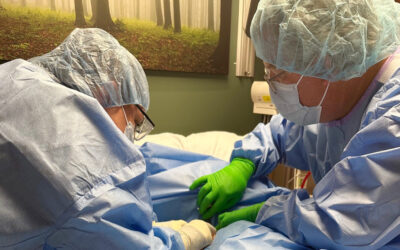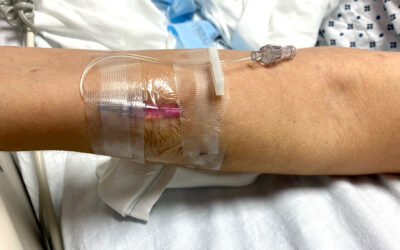Vascular Access Nurse Placed Temporary Dialysis Catheters can be safely placed, provided all nursing and other protocols are followed. Vascular Wellness, a leader in the field of vascular access, is one of a select few vascular access nurse companies that has a comprehensive program for Vascular Access Nurse Placed Temporary Dialysis Catheters, including policies, procedures, training materials, and competencies protected under intellectual property law. Vascular Access Nurse Placed Temporary Dialysis Catheters enable prompt and effective dialysis treatment and can efficiently supplement the reach and impact of any Vascular Surgery, Interventional Radiology, or Nephrology department or team.
Temporary Dialysis Catheters
Temporary Dialysis Catheters are large bore central venous catheters, meaning that they have large diameters that enable rapid fluid and blood administration, as well as the traditional filtering of blood during renal failure. In addition to usage as Temporary Dialysis Catheters, large bore catheters can be used in emergency situations such as in the Intensive Care Unit (ICU) or in the event of significant trauma or physical injury, as well as in certain non-emergency situations as clinically indicated. Large bore catheters can provide multiple points of access for various clinical scenarios, including heart rate monitoring, blood pressure monitoring, fluids, and medications. Large bore catheters such as those used for Temporary Dialysis Catheters are generally eight (8) French catheter or higher and Temporary Dialysis Catheters are typically inserted in the Internal Jugular or Femoral veins. While some clinicians may place these temporary dialysis catheter lines anatomically, Vascular Wellness places these lines using Ultrasound guidance which has been shown to be much safer for the patient. Placement is confirmed with X-ray prior to their use. In addition, Vascular Wellness places other large bore catheter lines such as Quad Lumens which can be very helpful when multiple points of access are needed.
Benefits of Temporary Dialysis Catheters
The benefits of Temporary Dialysis Catheters are clear and measurable, both clinically and financially. These benefits expand when Vascular Wellness vascular access nurses place the Temporary Dialysis Catheters at the bedside consistent with the benefits of other nurse-placed central venous lines at the bedside such as Internal Jugulars, Femorals, Axillaries, and PICCS. With the delivery of prompt vascular access even during after-hours, weekends, and holidays, patients are expected to have a better outcome and the risks of delayed therapy can be significantly reduced. Vascular Wellness provides the right line at the right time, which is important for a timely return to wellness for the patient. Other Benefits of Temporary Dialysis Catheters include the elimination of transportation expenses and the need for higher-cost medical specialists, each of which will afford financial savings for both the patient and the healthcare organization. Further, allowing physicians to care for all their patients rather than having their practice tied up procedurally, allows for the realization of efficiencies benefitting the patient, the facility and the individual physician. At Vascular Wellness, we have found that vascular access nurse-placed Temporary Dialysis Catheters at the bedside provides direct benefits to the patient as well as the facility and staff caring for them. Some benefits of Temporary Dialysis Catheters our patients’ experience include:
- Less hemorrhaging of blood during and after catheter insertion as a result of ultrasound expertise. Anticoagulation, poor platelet function, and trauma to the vessel can all contribute to additional bleeding.
- Lower rates of infection. All jugular placements are not the same. Our experienced clinicians are trained for a low jugular approach rather than the traditional approach higher on the neck. The resulting dressing is now kept cleaner and easier to maintain by the floor staff taking care of the patient. When a lower extremity approach is required our femoral lines utilize a mid-thigh rather than an inguinal fold approach. This is inherently a cleaner area and the dressing is also removed from high contamination areas, therefore, infections are reduced. Per CDC guidelines on reducing infection we use securement devices rather than sutures as sutures have been clinically shown to increase infection rates.
- Decreased need to undergo a more invasive procedure. A Temporary Dialysis Catheter can be clinically appropriate for a patient (a) who is waiting for a Permacath but needs immediate dialysis, (b) who is experiencing acute kidney failure (possibly from trauma) and needs temporary dialysis to help the kidney recover, and (c) who has pending cultures but needs emergency dialysis while a full treatment plan is being developed.
- Time to dialysis is greatly reduced as our responsive team generally has the catheter placed within 6 hours of order, and almost always on the same day. Delays in catheter placement often negatively affect a patients health, can increase their length of stay, and also has human resource costs in overtime to dialysis staff waiting to treat the patient.
Vascular Access Experts
As Vascular Access Experts, we continue to advance healthcare and empower nurses through our commitment to innovation, education, and the most favorable patient outcome. Nurse placement, or insertion of Temporary Dialysis Catheters, and other large-bore lines, are important examples of procedural care we provide to pursue our vision, as the Benefits of Temporary Dialysis Catheters are significant. Vascular Wellness is a full-service company comprised of Vascular Access Specialists and by bringing all the necessary equipment and supplies, we can efficiently and effectively handle virtually all large bore lines including Temporary Dialysis Catheters directly at the patient’s bedside. Our experience indicates that Vascular Access Nurse Placed Temporary Dialysis Catheter is the option most physicians prefer when clinically appropriate since the line can be implemented promptly, at a reduced cost, and can likely improve patient outcomes. Furthermore, Vascular Access Nurse Placed Temporary Dialysis Catheters enable the physician to treat other patients where that physician’s skill set and experience can best be used to expand healthcare access to all.
If you require Vascular Access or want to learn more, speak to the team at Vascular Wellness today. Follow us on LinkedIn, Facebook, Twitter, YouTube, and Instagram for the latest articles and insights.
Vascular Wellness Serves North Carolina, South Carolina, and Virginia and expanding to Georgia, Kentucky, Ohio, Tennessee, and West Virginia.






